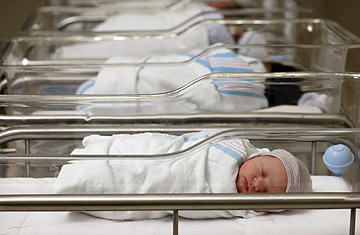
A newborn baby sleeps in a hospital nursery.
Cesarean sections were once a measure of last resort, a final attempt to save both mom and baby if things did not go well during delivery. That was almost certainly the case in Roman times with Julius Caesar, who was born via the procedure, and for whom it was named. But today, a trend toward elective cesareans is presenting doctors with another problem — women who insist on delivering earlier than they should, with potential risks to the newborn. Now, researchers at University of Alabama at Birmingham (UAB) and the Eunice Kennedy Shriver National Institute of Child Health and Human Development (NICHD) provide the first statistics to quantify exactly how dangerous that practice can be.
In a study of 13,258 pregnant women who had had a prior cesarean section, 36% elected to schedule their next c-section delivery before 39 weeks of gestation, the safety cutoff recommended by the American College of Obstetrics and Gynecology (ACOG). ACOG's guideline is based on studies showing that prior to 39 weeks, babies' lungs are often too undeveloped to function properly outside the womb, and babies at this age tend to have difficulty regulating their blood sugar. In the trial, led by Dr. Alan Tita at UAB and published in this week's New England Journal of Medicine, babies delivered at 37 weeks by elective C-section were twice as likely as those born at 39 weeks to have complications ranging from respiratory problems, heart issues, sepsis and seizures — conditions that typically require resuscitation or ventilator support in a neonatal intensive care unit. (See the Year in Health, from A to Z.)
"The fact that one-third of elective cesareans were done before 39 weeks was surprising," says Tita. "And we demonstrated an increase in morbidity associated with early delivery, which is why we think the ACOG recommendation should still stand, and that women should wait to have an elective cesarean until 39 weeks."
Why the trend toward earlier delivery? For many women, it comes down to convenience — to accommodate their work schedules or to avoid being pregnant any longer than necessary. Part of the trend may also be traced to women's confusion over the official guidelines: While ACOG recommends that 39 weeks of gestation is ideal for both vaginal and Cesarean deliveries, 37 weeks is technically considered full term. So, many women question why they have to wait an additional two weeks to schedule a c-section if their baby is at term.
Experts point out, however, that there is a difference between an elective cesarean, in which the doctor and mother are deciding when a baby will emerge from the womb, and a labor-induced delivery, which can occur any time after 37 weeks and in which the baby is initiating the process. "In a vaginal delivery, that baby instigated the labor, and is therefore ready and can be healthy at 37 weeks," says Dr. Catherine Spong, chief of the pregnancy and perinatology branch at NICHD and one of the co-authors of the paper. These results also do not apply to women who go into labor prior to 39 weeks and end up having a cesarean; likewise for them, the baby instigated the labor process and is more likely to be ready and healthy at whatever time the labor begins.
The new data will likely have the most impact on discussions between doctors and women who are planning a repeat elective cesarean. Although most obstetricians are disinclined to schedule c-sections prior to 39 weeks, they still feel pressured by their patients to do so. The new study ought to shift the substance of that dialogue, the authors hope. "This will be one more piece of useful information in any discussion about deciding when to schedule that delivery," says Tita, ideally in favor of the babies.
